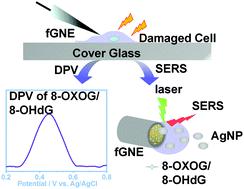Our official English website, www.x-mol.net, welcomes your
feedback! (Note: you will need to create a separate account there.)
Highly sensitive detection of DNA damage in living cells by SERS and electrochemical measurements using a flexible gold nanoelectrode
Analyst ( IF 3.6 ) Pub Date : 2021-2-11 , DOI: 10.1039/d1an00220a Jing Zhou 1, 2, 3, 4, 5 , Dan Yang 1, 2, 3, 4, 5 , Guohui Liu 1, 2, 3, 4, 5 , Siying Li 1, 2, 3, 4, 5 , Wennan Feng 1, 2, 3, 4, 5 , Guocheng Yang 1, 2, 3, 4, 5 , Jin He 6, 7, 8, 9 , Yuping Shan 1, 2, 3, 4, 5
Analyst ( IF 3.6 ) Pub Date : 2021-2-11 , DOI: 10.1039/d1an00220a Jing Zhou 1, 2, 3, 4, 5 , Dan Yang 1, 2, 3, 4, 5 , Guohui Liu 1, 2, 3, 4, 5 , Siying Li 1, 2, 3, 4, 5 , Wennan Feng 1, 2, 3, 4, 5 , Guocheng Yang 1, 2, 3, 4, 5 , Jin He 6, 7, 8, 9 , Yuping Shan 1, 2, 3, 4, 5
Affiliation

|
Guanine (G) oxidation products, such as 8-hydroxy-2′-deoxyguanosine (8-OHdG) and 8-oxo-guanine (8-OXOG), have been widely studied as promising biomarkers for DNA oxidative damage. In this work, we develop a new method to detect G oxidative products released from live cells after chromium (VI) ion or hydrogen peroxide treatments by using a glass nanopipette-based flexible gold nanoelectrode (fGNE). Specific response to G oxidative products with high sensitivity can be detected from the fGNE tip through integrated electrochemical measurements and surface-enhanced Raman spectroscopy. The fGNE apex can be positioned very close to the cell membrane noninvasively because of its high flexibility and nanoscale tip size. With the assistance of the electrophoretic force, the fGNEs can effectively collect and detect the G-derived DNA damage products released from individual cells in the cell culture medium with high sensitivity.
中文翻译:

通过SERS进行活细胞DNA损伤的高灵敏检测以及使用柔性金纳米电极的电化学测量
鸟嘌呤(G)氧化产物,例如8-羟基-2'-脱氧鸟嘌呤(8-OHdG)和8-氧代鸟嘌呤(8-OXOG),已被广泛用作DNA氧化损伤的有前途的生物标记。在这项工作中,我们开发了一种检测铬后从活细胞释放的G氧化产物的新方法(VI)离子或过氧化氢处理,方法是使用基于玻璃纳米吸管的柔性金纳米电极(fGNE)。可以通过集成的电化学测量和表面增强拉曼光谱从fGNE尖端检测出对G氧化产物具有高灵敏度的特异性反应。由于fGNE顶点具有很高的柔韧性和纳米级尖端尺寸,因此可以无创地定位在非常接近细胞膜的位置。借助电泳力,fGNE可以高效地收集和检测从细胞培养基中单个细胞释放的G衍生的DNA损伤产物。
更新日期:2021-02-24
中文翻译:

通过SERS进行活细胞DNA损伤的高灵敏检测以及使用柔性金纳米电极的电化学测量
鸟嘌呤(G)氧化产物,例如8-羟基-2'-脱氧鸟嘌呤(8-OHdG)和8-氧代鸟嘌呤(8-OXOG),已被广泛用作DNA氧化损伤的有前途的生物标记。在这项工作中,我们开发了一种检测铬后从活细胞释放的G氧化产物的新方法(VI)离子或过氧化氢处理,方法是使用基于玻璃纳米吸管的柔性金纳米电极(fGNE)。可以通过集成的电化学测量和表面增强拉曼光谱从fGNE尖端检测出对G氧化产物具有高灵敏度的特异性反应。由于fGNE顶点具有很高的柔韧性和纳米级尖端尺寸,因此可以无创地定位在非常接近细胞膜的位置。借助电泳力,fGNE可以高效地收集和检测从细胞培养基中单个细胞释放的G衍生的DNA损伤产物。











































 京公网安备 11010802027423号
京公网安备 11010802027423号